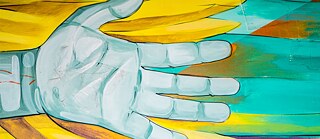Biblioteca, Universidad Autónoma de México (UAM), Azcapotzalco, CDMX
"Diversity" by Colectivo Chiquitraca
Death as the force that judges everything and everyone: that is precisely what the Chiquitraca artists’ collective from Juchitán in the Mexican state of Oaxaca wants to express in collaboration with other Mexican artists. Together, they created a mural on the campus of the Universidad Autónoma Metropolitana Azcapotzalco (UAM) in Mexico City.
For an event about gender equality and diversity that was held from January 21 to 22, 2020, art projects were developed by Mexican artists and students on the UAM campus in Mexico City; one of them is Chiquitraca’s mural.
The colorful artwork that the Chiquitraca collective produced with artists from other Mexican collectives in Azcapotzalco extends across eight meters of canvas. Two praying mantises stand out clearly from the center of the canvas. They face one another in dance poses, with two masks to their sides watching the viewers directly. The two masks show characteristic differences: one has obvious feminine and the other masculine traits. Both are decorated by bones and skulls.
The masks represent the different genders, as do the angel halves painted by Gotha (one of the artists belonging to the Chiquitraca collective) that can be seen on both ends of the canvas. Like the masks, the angels also have feminine and masculine traits. “Originally”, admits Gotha, “there was supposed to be a representative angel of the third gender in the center of the canvas”, but in the end the artists had to reject this idea. Nonetheless, the artwork is intended to depict the equality of all genders in society.
The elements that represent the genders are decorated by various animals: crows, dragon flies, and wolves adorn the artwork and lend it greater depth, as do the blossoms and plants in their bright colors. All the different elements cause the observer to discover more and more details as they look upon the work, such as the patterns in the corners that are inspired by the Mayan culture or the colorful dragon flies that appear to fly through the painting. Just like the masks, they are all united by attributes of death and links to the Mexican culture.
Fish bones can be seen rather than fish, and several skulls seem to be hidden in the painting. The animals are supposed to represent freedom per se, as well as gender freedom. “Unfortunately, tolerance of personal expression is often something that is lacking in Mexican society”, says Gotha.
The colorful artwork that the Chiquitraca collective produced with artists from other Mexican collectives in Azcapotzalco extends across eight meters of canvas. Two praying mantises stand out clearly from the center of the canvas. They face one another in dance poses, with two masks to their sides watching the viewers directly. The two masks show characteristic differences: one has obvious feminine and the other masculine traits. Both are decorated by bones and skulls.
The masks represent the different genders, as do the angel halves painted by Gotha (one of the artists belonging to the Chiquitraca collective) that can be seen on both ends of the canvas. Like the masks, the angels also have feminine and masculine traits. “Originally”, admits Gotha, “there was supposed to be a representative angel of the third gender in the center of the canvas”, but in the end the artists had to reject this idea. Nonetheless, the artwork is intended to depict the equality of all genders in society.
All are equal in the face of death
Jesús Vicente aka Gotha







